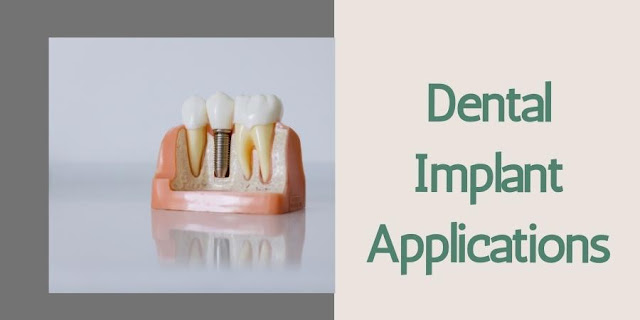How are Dental Implant Applications Done?
Dental implants are artificial tooth roots made of biocompatible materials such as titanium that are surgically placed into the jawbone to support replacement teeth or dental prostheses. They have various applications in modern dentistry, primarily for restoring missing teeth and improving oral health and aesthetics. Here are some common dental implant applications:
 |
| Dental Implant Applications |
Single Tooth Replacement: Dental implants can be used to replace a single missing tooth without affecting neighboring teeth. A crown is attached to the implant, mimicking the appearance and function of a natural tooth.
Multiple Teeth Replacement: When multiple adjacent teeth are missing, a bridge supported by dental implants can be used to replace them, offering a stable and aesthetically pleasing solution.
Full-Arch Replacement: For patients who have lost most or all of their teeth, full-arch dental implant restorations, such as All-on-4 or All-on-6, can replace an entire arch of teeth. These implant-supported bridges or dentures are fixed in place and provide a more comfortable and natural alternative to traditional removable dentures.
Overdentures: Dental implants can be used to support removable dentures, providing greater stability and reducing issues like slipping or discomfort often associated with traditional dentures. This approach is particularly beneficial for lower jaw dentures.
Implant-Supported Prostheses: In cases where a patient has lost all their teeth or is edentulous, implant-supported prostheses, including full dentures or partial dentures, can be designed to attach to dental implants for improved stability, comfort, and functionality.
Orthodontic Anchorage: Dental implants can be used as stable anchor points in orthodontic treatments, especially when conventional methods may not be sufficient. They can assist in moving teeth into their correct positions.
Ridge Preservation: After tooth extraction, dental implants can be placed immediately or after a healing period to prevent bone loss and preserve the shape and volume of the jawbone in the extraction site.
Sinus Lift and Bone Augmentation: In cases where the jawbone lacks adequate height or density to support dental implants, procedures such as sinus lifts and bone grafts can be performed to create a suitable foundation for implant placement.
Resorption Correction: Dental implants can help counteract bone resorption, which occurs when teeth are lost and the jawbone begins to shrink. Implants stimulate the bone and prevent further deterioration.
Facial Rejuvenation: In some cases, dental implants can be strategically placed to provide support for facial prostheses, helping individuals who have lost facial structures due to trauma, cancer, or congenital conditions.
Implant-Supported Crowns for Restoring Teeth: Dental implants can also be used to provide additional support for weakened or damaged natural teeth, preserving them and preventing the need for extraction.
Dental implants have revolutionized the field of restorative dentistry, offering a long-lasting, natural-looking solution for various dental issues. The specific application of dental implants depends on the patient's unique needs and oral health conditions, and a consultation with a qualified dentist or oral surgeon is essential to determine the most suitable treatment plan.

Dental implants can be used to support removable dentures, providing greater stability and reducing issues like slipping or discomfort often associated with traditional dentures. This approach is particularly beneficial for lower jaw dentures.
ReplyDelete